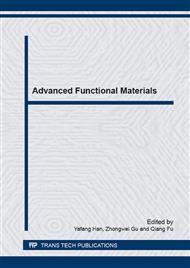p.367
p.373
p.379
p.385
p.390
p.396
p.401
p.407
p.412
Cytocompatibility of Fe-O Thin Film Prepared by Unbalanced Magnetron Sputtering
Abstract:
In order to improve the cell biocompatibility of pure iron surface as cardio-vascular stent material, Fe-O film was deposited on single crystal silicon by unbalanced magnetron sputtering. Human umbilical vein endothelial cells were seeded on the 316L SS, pure iron and Fe-O film surface, whereafter cultured in vitro. Adhesion behavior was detected after 2 h incubation. Cell morphology and proliferation activities were assessed at 1, 3 and 5 days. The results show that the endothelial cells are easy to adhere and spread on the surface of Fe-O film. Compared with 316L SS samples, the cells count and area coverage of Fe-O film in 1 and 5 days make a difference significantly. These results demonstrated that the Fe-O film prepared by unbalanced magnetron sputtering technique has good cytocompatibility.
Info:
Periodical:
Pages:
390-395
Citation:
Online since:
March 2015
Authors:
Price:
Сopyright:
© 2015 Trans Tech Publications Ltd. All Rights Reserved
Share:
Citation:


